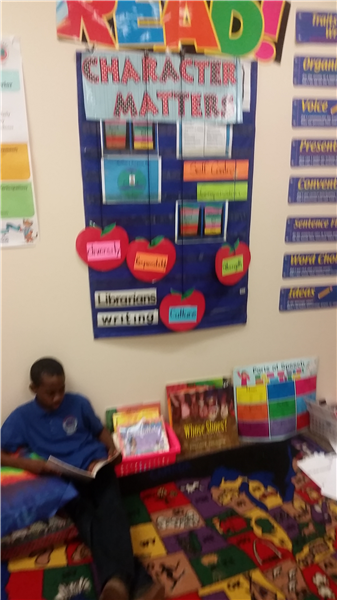| Click to go to the website Click to see previous newsletters | ||
 |
||
| Chesapeake Math & IT Academy Elementary | ||
|
CMITE102 10/01/2017 |
||
| Administrative Announcements | ||||||
| Pick-up and Drop off Reminders | ||||||
|
In the morning when dropping of your child, please remember to make a double line. Do not let your child out of the car before the first stop sign. When you stop after the first stop sign, put your car in park and let your child out of the car. Wait until the staff member with the manual "stop and go" sign turn it to "go." Then, proceed slowly out of the parking lot looking out for children.
During pick-up in the afternoon, please have your child number visible in the dashboard. We still have some students that do not know their number. Please help you child with learning his or her number. DO NOT PARK IN THE PARKING SPACES ON THE SIDE OF THE BUILDING DURING DISMISSAL. This causes a traffic jam and it is not fair to the parents who are following our procedures to have to wait for you to back out because you did not follow directions. Let's all work together to have a smooth dismissal. Tenika Fryson |
||||||
| Top | ||||||
| Class Dojo Monthly Awards | ||||||
|
This week is the last week to earn dojo points for the first month of school. Please check Class Dojo to see how close your child is to meeting his or her monthly goal. Each child that meet their monthly goal will get the following:
*highlighted on the morning announcements and the dojo bulletin board. *receive a certificate from his or her teacher. *be able to participate in our dress-down day, which will be announced. *be eligible to be a student of the month. Our dates for earning points for our second month of school is October 6- November 6. If your child meets the goal for the first and second month, he or she will be invited to the Quarterly Class Dojo Celebration! I will need volunteers for quarterly celebrations. So if you are cleared through PGCPS, please contact our front office to add your name to our volunteer list. Tenika Fryson |
||||||
| Top | ||||||
| FYI | ||||||
| ROBOTICS LEGO CONTEST | ||||||
|
Hello, Everyone
I am happy to share with you that CMIT ELEMENTARY School will participate 3RD Robotics First Lego League Competition soon. We are so excited to participate this year with your scholar students. Our CMIT Elementary School will do best this year too. First Lego League introduces a scientific and real-work challenge for teams to focus and research on. Sincerely, Mr. INCI LEGO TEACHER |
||||||
| Top | ||||||
| TIGER READS! | ||||||
|
Tiger Reads!
Dear Parents/Guardians, Create a reading nook this week. If you have already done so, go ahead and share with us. I am so proud of the scholars who are reading each evening. Thank you parents for your support as we go on a journey this school year. I would like to introduce the story that 4th graders read. It’s called, Because of Winn Dixie. This book is very exciting and your scholars will totally enjoy reading and rereading this with you. Young children will also enjoy listening to you read this story. They will want to ask questions. The story is also available on utube - https://www.youtube.com/watch? v=O79JYsGcrLw The paperback version is 2.99-check Amazon. If you want a really cool story to read with your scholars, check this one out. Reading Quote: “The more that you read, the more things you will know. The more you learn, the more places you’ll go.”-Dr. Seuss, “I Can Read with my Eyes Shut!” Remember to share your reading, I want to know what you are reading. Stay true to this challenge. Thanks again parents for the many opportunities you provide for reading outside of school. Read On..... Lesma Watson Watkis |
||||||
| Top | ||||||
| STEM FAIR | ||||||
|
STEM fair packets will be released online in next weeks newsletter. Timelines will also be sent home October 5th! Please have your child start to explore possible STEM fair topics.
Link to possible STEM fair project ideas http://www.education.com/science-fair/ Please contact Benora Mccain'Wigfall at bmccain@cmitelementary with any questions. Benora McCain |
||||||
| Top | ||||||
| CMIT E Clubs | ||||||
|
Dear Parents;
Welcome back to another exciting school year where you will find many opportunities for learning, exploring, and leadership. Please read the description of each club in attached club booklet and follow specific directions at the end of club booklet if you are interested in applying for a club. How to Enroll: ***Parents will receive a Club Booklet via CMIT E’s newsletter. ***An online Club Registration Form will be shared with parents on Monday, October 2nd. Club registrations will close on Tuesday, October 10th. (Club Registrations do not secure the club enrollment. If there are more applications than available spots, there will be a lottery to place the students into the clubs.) ***Parents will be notified about their club enrollment on Thursday, October 12th. ***Clubs start on Monday, October 16th. ***Students to be enrolled in one club only due to the high interest. ***Club enrollment is subject to change according to the academic/behavior performance in the school.
Attachment(s)
CMIT Elementary |
||||||
| Top | ||||||
| UPCOMING EVENTS | ||||||
| Future Events/Assessments... | ||||||
|
October 2nd - 13th: I-Ready Diagnostic Assessment - RTI students only
October 16th: 1st day of clubs October 20th: PD Day - School closed for Students |
||||||
| Top | ||||||
| Kindergarten | ||||||
| Kindergarten at a Glance | ||||||
|
Last week in kindergarten, we began talking about respect! We discussed what respect looks like and sounds like in different settings. In science we discussed problem solving and began learning how to make a plan! In math we focused on counting, comparing, and ordering numbers to 5!
This week in Kindergarten... Character Education We will continue discussing respect and how that translates to recess, lunch, CARTS, home, etc. English Language Arts We will be reading the story "We Are So Proud!" Along with the story, we will be learning about setting, syllables, and naming, sounding, writing letters to J. We will continue working with the sight words I and am. Mathematics We will continue counting, comparing, and ordering numbers to 5! Science We will wrap up our unit on problem solving and begin learning about motion! Lastly, just a few dates and reminders: - MAP testing will begin this week. -Please send an extra uniform for scholars to keep at school. Accidents happen! -Please continue to reinforce classroom and school rules and procedures (i.e. hands to self, being respectful, following directions the first time, etc.) - Please be sure to label all personal items and also reinforce responsibility with your scholars. - Uniform is enforced daily, including uninterrupted black shoes. Please go to http://cmitelementary.org/uniform-policy/ for more information. -The Kindergarten Team |
||||||
| Top | ||||||
| 1st Grade | ||||||
| 1st Grade | ||||||
|
Next week in First Grade:
RELA: Alexander and the Horrible, Terrible, No Good, Very Bad Day Reading Skills: Problem and solution, visualizing Spelling: Short and long 'o' Grammar: Adjectives and verbs Math: We will continue to work on counting by 1s and 10s to 120 and counting on an open number line. Social Studies: My Rights, My Responsibilities - How can we help others? What are the rules at home? Science: How do scientists collect data? How do scientists share data? How do they use science tools? First Grade Team |
||||||
| Top | ||||||
| 2nd Grade | ||||||
| 2nd Grade Updates | ||||||
|
Hello Parents,
We're now almost done with our first month of school and our students have been working hard. Please make sure that students turn in homework packets completed (and reviewed by you) by Friday mornings. Students are expected to be responsible to take the homework packets home at the beginning of the week and return it back on time. Please ensure students are reading and entering their information on reading logs. It is advisable that students respond to reading by discussing what they've read with you or another adult. We need second graders to master their basic math facts up to 20 (0-20) in addition and subtraction. Please ensure your child has a set of flashcards for each to review at home. All 2nd grade teachers will be offering timed drills to help ensure mastery. There will be a grade level competition in the winter, so let's start preparing now! 2nd grade team |
||||||
| Top | ||||||
| 3rd Grade | ||||||
| Fall into Learning! | ||||||
|
Hello Parents,
In the upcoming week, scholars will be learning the following: Language Arts- scholars will explore the concept of working cooperatively to achieve their goals, by reading, writing, and discussing Social Studies- scholars have received their "Create-a-Community" project due on October 9. Math-scholars will continue rounding numbers to the nearest ten and hundreds place and understanding place value Science-scholars are still discussing weather Parents please remember to initial reading logs and the math/science homework calendar. Third Grade Team |
||||||
| Top | ||||||
| 4th Grade | ||||||
| 4th Grade News | ||||||
|
Ms. Webb's Math and Science Class:
Next week: Math: In math we are continuing with place value. Student will use their knowledge to compare, order, and round greater numbers. Science: In Science we are going to use what we learned about the Scientific Method, science skills and tools, and the Engineering Design Process, to conduct and investigation. Students will begin Earth Science Module 1 as well. Mrs. Inci's Math and Science Class This was another great week with 4th grade. MAP testing is done!!!!! I'm happy to announce that CMIT Elementary school will participate some math contests. Student selections will be announced soon. Parents/Guradians please make sure that scholars turn in homework on time. This week, our scholars focused on ordering and rounding numbers in math. Also, it was so fun to learn and teach science. I really enjoyed to see these sparkling eyes while teaching fossils. Mr. Mogilski and Ms. McAllister's Reading and Social Studies Classes: We had a great week in Reading and Social Studies! We finally completed MAP Testing! We will share results in the coming weeks. We read a great historical fiction text called "Lewis and Clark and Me." We challenge all of our parents to ask their scholar to summarize the story for them sometime this weekend! In Social Studies, we are learning how to use maps and the features of maps. Students are even designing their own map of CMIT! |
||||||
| Top | ||||||
| 5th Grade | ||||||
| This week's Learning Experience | ||||||
|
RELA
Students discussed inner conversation and how to apply it when we are reading various books. Students focused on explaining and writing explicitly what is being read in the text. We have finished Red Kayak and have taken the spelling test and Reading test this week. Social Studies Students identified ways to read a map and regions on the map. Students were to create a map from their home to school for homework. The pictures above are students playing Kahoot to ensure their understanding. Science Understanding Earths Place in the Universe Phenomenon- The Sun Rising and Setting 1. Engaging in Argument from Evidence 2. The Universe and it’s Stars 3. Scale, Proportion, Quantity 4. Analyzing and Interpreting Data 5. Patterns 6. Earth and Our Solar System Math Understanding Place Value Recognizing patterns or structure can be represented in different ways. Comparing numbers Evaluating standing knowledge of whole number Hands on learning through the use of manipulatives and technology Terri Keys |
||||||
| Top | ||||||
| Counselors Corner | ||||||
| zzzzZ Bed Time! Zzzzz | ||||||
|
Hello Tigers Den! We all know that the transition from summer schedules back into our school routine, is challenging. By now we have found our "groove" again, with our stamina still building up for the demands of our working days. What we don't always consider though, is the invaluable importance of sleep, and how we have been misunderstanding the "rules" around sleep. It remains our strongest preparation and greatest tool to tackle all of our tasks, and I found the following article about how we get out sleep, fascinating! It certainly "debunked" some myths I had been believing for a while, and got me thinking in more non-conventional ways about getting those "Zzzzz's" in. We Know Remarkably Little About The “Right” Bedtime By, Stephanie Loomis Pappas (https://www.parent.co) Plenty of parenting websites will tell you the “right” time to put your children to bed. Many of these resources even include age-based charts broken into 15-minute sleeping and waking intervals so you’ll know that if your five-year-old goes to bed at 6:45, she should be up at 6:00. Surprisingly, these sleep guidelines are based on remarkably little evidence. Before you waste time charting your child’s sleep or struggle to get your kids into bed while the sun’s still up, read up on what’s known about sleep, what’s unknown, and what’s negotiable. Sleep is poorly understood We all know we’re supposed to be getting eight hours of sleep a night. We know that our kids are supposed to be getting more than that. We also know that our families generally fall short of those guidelines, whether it’s demanding work schedules, sleep-resistant toddlers, or just needing to enjoy our quiet houses in the late-night hours. How do we know how much sleep we need? Emmanuel Mignot, director of the Center for Sleep Sciences and Medicine at Stanford, calls sleep “one of the last remaining mysteries in biology.” We know we need to sleep, but we don’t really know why we need to sleep for a third of our lives, or why sleep-deprivation is so profoundly damaging. Part of why sleep is poorly understood is that it’s really difficult to study. Sleep is governed by the brain, and brains are hard to study. Sleep studies are time consuming and expensive. They often require getting subjects to sleep in a lab connected to various wires and measurement tools for a prolonged period of time. As a result, sleep studies tend to be quite small. Even then, the results are not necessarily applicable to the population at large. Children with sleep issues may undergo sleep testing to study their sleep patterns. These sleep studies are helpful in diagnosing and treating a range of medical concerns, from sleep apnea to sleepwalking, but they cannot be generalized to how all children should sleep. Sleep recommendations are broad. If the available sleep studies don’t explain how much we should sleep, where do these recommendations come from? How do professional sleep organizations know what amount of sleep is ideal for children of each age group? In a review of 100 years’ of sleep recommendations, Lisa Anne Matricianni and colleagues found that only one of 35 formal recommendations provided specific scientific rationale behind its conclusions. The reviewers concluded that, “after more than 100 years, sleep recommendations are still being issued in the acknowledged absence of meaningful evidence.” In short, the organizations making recommendations about children’s sleep are not necessarily basing their guidelines on very strong evidence about children’s sleep habits. The evidence tends to be largely anecdotal and practice-based, and while these observations have value, they are often the starting point, not the end point, of scientific research. The lack of good sleep evidence makes sense. No study is going to definitively prove how much sleep anyone needs, because such a study would need to follow a subject over the course of a lifetime. It would require decades-long data collection on daily sleep, diet, and exercise, and even then there would be so many confounding variables that it would be difficult to draw definitive conclusions about how much sleep is necessary. Although they were not able to pinpoint strong evidence undergirding each set of recommendations, Matricianni and colleagues found remarkable similarities between the rationales for the amount of sleep recommended in each set of guidelines. In nearly every case, there is expressed concern for children not getting “enough” sleep. The reviewers noted that, whether it was 1897 or 2007, people believed children’s sleep to be adversely affected by modern life, from schoolbooks then to the internet now. Perhaps the most comprehensive sleep guidelines to date are those put out by the American Academy of Sleep Medicine (AASM) in 2016. Drawing from hundreds of sleep studies, the AASM recommends the following daily sleep amounts for children: 12 to 16 hours for infants aged four to 12 months 11 to 14 hours for one- to two-year-olds 10 to 13 hours for three- to five-year-olds 9 to 12 hours for six- to 12-year-olds 8 to 10 hours for 13- to 18-year-olds These recommendations, which were endorsed by the American Academy of Pediatrics, are for total sleep time, including naps, during each 24-hour period. The first thing to notice about these guidelines is how broad they are. There are wide gaps between the low and high sleep amounts for each group. There are also no optimal bedtimes included within the guidelines, or even the requirement that the sleep be continuous. The looseness of the guidelines suggests that either individuals’ sleep needs are so different as to defy categorization, or there is just not enough strong data to draw a definitive conclusion about sleep needs. The American early bedtime: The above AASM recommendations do not recommend a specific bedtime or wake time, but instead an overall amount of sleep by age group. When translated into articles about parenting, those recommendations often turn into strict requirements for children’s ideal bedtimes. That’s not necessarily because earlier is better, but because American parenting – and American daily life in general – requires early bedtimes for us all. First, our kids have to go to bed early because they have to get up early, a point Slate parenting columnist Melinda Wenner Moyer makes in her defense of the “absurdly early bedtime.” When we say that putting kids to bed early is better, we gloss over a really important distinction. It’s not the early bedtime that matters so much as the amount of sleep children get. Children who go to bed at 7:00 can get 11 hours of sleep. Children who go to bed at 9:00 can get 11 hours of sleep. The difference is that, when parents have to be at work early, kids have to be awake early. Second, our kids have to go to bed early because we need “alone” time. Stories about early bedtimes often include the “me” time that parents want away from their children. There’s no evidence that late bedtimes need to disrupt this sacred time for parents. That need for “me” time stems from more than just sleep schedules. It comes from our own cultural expectation to be 100 percent present with our children. The combination of early morning wake times and the hyper-involved parenting expectations of many Americans is a losing combination that means somebody – maybe everybody – isn’t getting enough sleep. Sleep is cultural The sleep guidelines offered by the AASM suggest that there are many different routes to the “right” amount of sleep. Internationally, that seems to be true. How kids get their sleep differs dramatically from one country to the next. Even as we try to find the “right” bedtime, we can probably all recognize that people sleep differently and happily in different countries (think siestas!). Joanna Goddard’s eye-opening Motherhood Around the World series helps showcase the difference in a wide range of parenting styles, including attitudes toward sleep, from Italian playdates that extend past many American kids’ bedtimes, midnight snuggles during Icelandic summers, and shared bedtimes for Indian parents and kids alike. As examples from different countries show, there isn’t necessarily a “right” way to get a full night’s sleep. Armed with that knowledge, parents should feel more comfortable negotiating sleep times that work best for their kids and themselves, whether that’s two-hour midday naps or getting the kids in bed before sunset. (Written by, Stephanie Loomis Pappas) Graciously, Your School Counselor |
||||||
| Top | ||||||
| Special Education | ||||||
| How should we handle boys who can't read? | ||||||
|
From the desk of Science Daily
"Many people know that girls, on average, are worse at math than boys. But the gender difference is three times greater when it comes to reading. According to international studies, this is where boys struggle. Why? And what can be done about it? For starters, children who struggle most with learning to read could be identified earlier than is currently done. And now, researchers are finding new ways to do this. "Letter-sound knowledge is what best predicts how well students will be able to read later," says Professor Hermundur Sigmundsson at the Norwegian University of Science and Technology's (NTNU) Department of Psychology. He has based his research on major empirical studies and theory. Young children who are good at recognizing their letters and sounds early often become the best readers later on, too. We now know that children develop skills mainly through experience and stimuli. Other recent research shows that we get good at exactly what we practice. We need to develop nerve connections in the brain through our actions. Sigmundsson believes it is important to use evidence-based learning methods that are effective for both sexes. He thinks that all students' reading skills should be checked when they start primary school. This assessment is easy and only takes a few minutes per child. "We have to give the boys a boost by finding where each individual student stands. We can do that by emphasizing letters and the sounds that are associated with them. We need to make sure that all children have a good command of letter-sound relationships as early as possible once they start school," he said." Read more here: https://www.sciencedaily.com/releases/2017/09/170912093133.htm Shannon McVeigh |
||||||
| Top | ||||||
| FAQs | ||||||
 |
||||||
|
|
||||||
| Top↑ | ||||||
| Chesapeake Math and IT Elementary | ||||
| 6151 Chevy Chase Dr, Laurel, MD 20707 | Tel: (240) 573-7240 | ||||
| cmitelementary.org | ||||
| STAY CONNECTED / INTERACT | ||||
| CMIT Elementary is on | Chesapeake Lighthouse Foundation is on | |||
| Unsubscribe | Subscribe |
![original-1552009-2[1].jpg](https://newsletter.clfportal.org/_UploadedFiles/246037_CAP_16gyt2892017.jpg)



